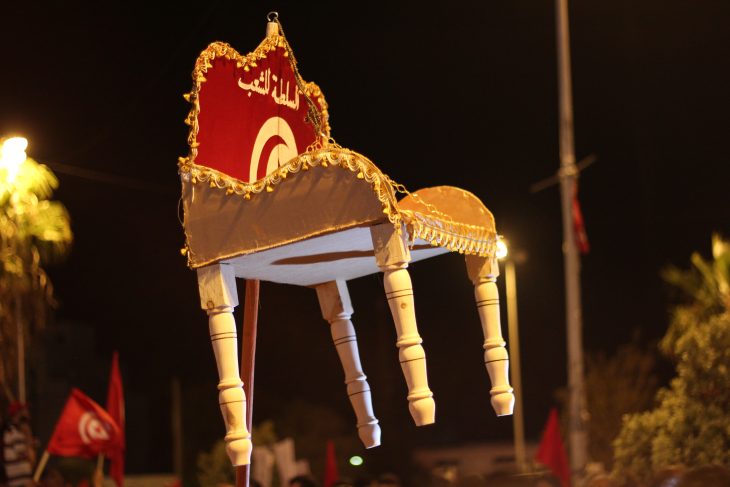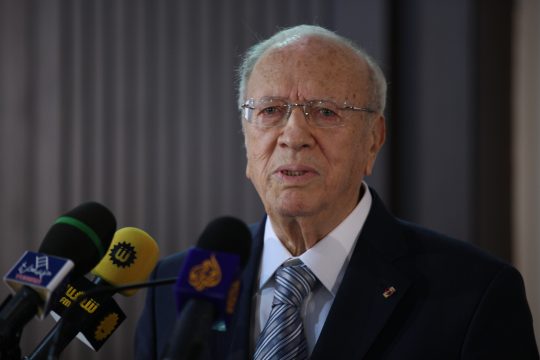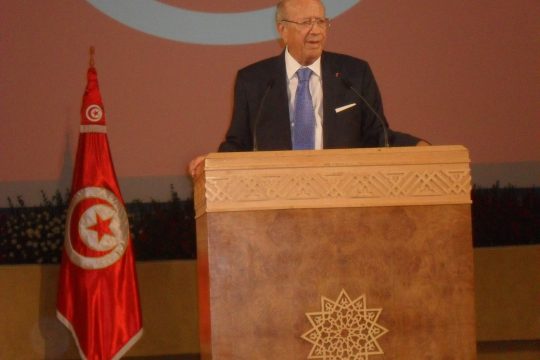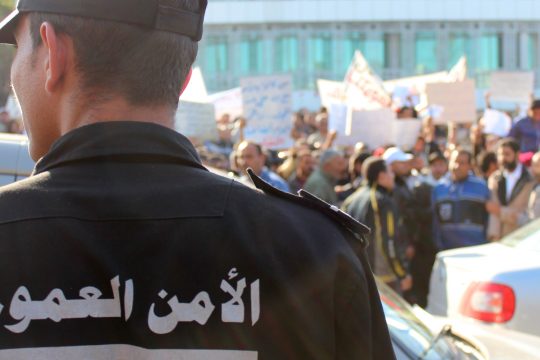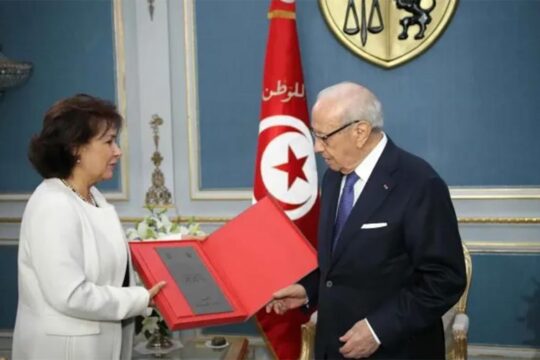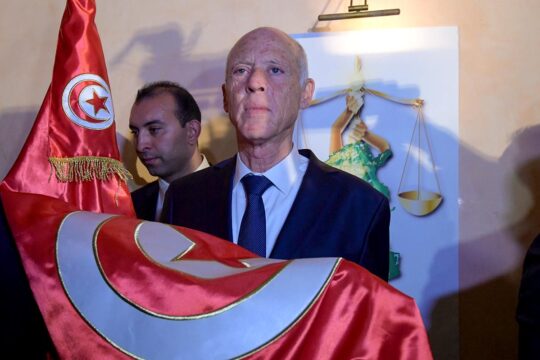In Tunisia, soon after the fall of the Ben Ali regime in January 2011, the toolkit of transitional justice was almost immediately put in place. Countless conferences, workshops and seminars were organized by the international community almost immediately after the revolution to sensitize the temporary government and civil society organizations about the importance of transitional justice, and “sell” its tools to local actors. Tunisia appeared to many as the perfect laboratory for a comprehensive transitional justice approach that would then, hopefully, resonate in the entire Arab region. However, despite official attempts to present transitional justice as a depoliticized and purely legal approach to dealing with a legacy of gross human rights violations, discourses on “facing the past” in Tunisia were rapidly instrumentalized in a political fashion. By putting forward a specific categorization of victims, and by promoting certain reparation schemes, a specific story about the past was told, and, thereby, a different form of political project was served. Transitional justice thus appeared in Tunisia, in spite of the efforts of the international community to “legalize” it, as an intrinsically political instrument of legitimization for the power in place. As such, the new government of “Nidaa Tounes” – which is mostly composed of representatives of the former regime – has recently pointed to the security and economic crises triggered by the rise of terrorism and sought to promote “reconciliation” by granting amnesty to corrupt businessmen at the expense of truth and accountability. This piece seeks to reflect on the Tunisian transitional justice process in order to understand the limits of a mechanistic, “ticking box” approach and defend a more transformative and political one, that would truly address the root causes of violence.
The immolation of Mohamed Bouazizi, a vegetable seller from Sidi Bouzid, on December 17th, 2010, was yet another tragedy in a long series of violations endured by Tunisians since their country’s independence, but it was enough to spur a national uprising that would eventually end in President Ben Ali’s escape to Saudi Arabia on January 14th, 2011, leading the country to its first free elections a few months later. However, the legacy of violations that the newly democratic country would have to deal with runs deep, as it includes years of oppression against both the leftist and Islamist oppositions, systematic torture, arbitrary arrests, as well as endemic corruption and the economic marginalization of entire regions. While President Ben Ali was probably not aware of this, it was during his last speech on January 13th 2011 on national television that he opened the debate on transitional justice in Tunisia. Trying in vain to ease social tensions, he announced the opening of a fair and transparent investigation into crimes committed by security forces against demonstrators. Ultimately, three commissions were created after the revolution: (1) a Commission of inquiry on human rights violations committed during the demonstrations, (2) a Commission of investigation on corruption and embezzlement, and (3) a Commission for political reform and the accomplishment of the objectives of the revolution. This choice reflects several particularities in Tunisia’s path to transitional justice: first, the inclusion of corruption and socio-economic crimes into its mandate; second, the fragmentation of the process into several distinct and unrelated mechanisms; and third, the links between transitional justice and the revolutionary process.
Despite the creation of these inquiry commissions, debates on transitional justice in Tunisia rapidly focused on the sole issue of reparations. A first decree-law was promulgated on February 19th 2011, providing for an important reparations and rehabilitation scheme that includes the recruitment of all beneficiaries of the amnesty program into the public sector and the administration, as well as financial compensations and medical support. The decree grants amnesty to all individuals who have been arrested or condemned for political reasons since 1989, including for violating the protest law or for belonging to an illegal organization. Since many beneficiaries of the amnesty were Islamists, as they were the ones most targeted and arrested during the last years of the regime, a section of the population regarded the reparations with suspicion, perceiving them as a way for the ruling Islamist party to reward their troops, rather than as a legal acknowledgement for victims of gross human rights violations. Another decree-law on reparations, however, adopted in October 2011, grants “martyrs and wounded of the revolution” a set of material and symbolic reparations as well, but was limited to persons that have been wounded or killed while “risking their lives to defend the goals of the revolution”, thereby implicitly conditioning the granting of reparations to the nobleness of the political goals pursued by their beneficiaries. The decision to adopt two distinct programs of reparations dedicated to two distinct types of victims has further contributed to the fragmentation of a process that seemed, from the start, to be lacking a comprehensive and inclusive understanding of transitional justice.
As with reparations, accountability was promoted in Tunisia in a disconnected and somehow incoherent manner. Several trials of former regime dignitaries took place before the drafting of a comprehensive transitional justice law, and before any attempts to reform the justice system. As a consequence, these trials were generally considered to be unfair, as they failed to provide for fundamental judicial guarantees. The decision to transfer most transitional justice-related cases to military courts raised suspicions about their impartiality, since the cases always involved security forces. At present, only a handful of human rights cases have gone to court, mostly for deaths and injuries inflicted by the security forces when they were trying to suppress the 2010-2011 uprising. Out of the thousands of reported torture cases, only one has gone to trial, resulting in the sentencing of a former Interior minister and other high-level security forces to only two years in prison, due to legal obstacles and non-retroactivity. The defense rapidly qualified these trials as “show trials” that were targeting only a few scapegoats and violating basic fair trial rights.
The temporally limited mandate of transitional justice mechanisms is also highly contentious in Tunisia, and soon became the subject of intense debates and memorial contestations. The secular fringe of society on the one hand, tends to prefer limiting the timeframe of the Truth Commission to only investigating abuses of the Ben Ali era, in order to preserve Bouguiba’s legacy as the modernist father of Independence. Islamists, on the other hand, prefer to go back to the pre-independence period or even the French protectorate, in order to question the founding myth of the Tunisian state and underline its religious and pan-Arab origins represented by Ben Youssef’s movement. Another important debate pertains to the reparations decree for “martyrs and wounded of the revolution”, which decided that the revolution started on December 17th, 2010 with the immolation of Mohamed Bouazizi, thereby excluding from its schemes persons that have been killed or shot during the prior demonstrations that also led to the revolution, most notably the 2008 mining region uprising in Gafsa. The process of determining the beneficiaries of the reparations was therefore also a way to determine the very nature of the revolution, when exactly it started and who its victims were. As such, the outcome of this process was a historical statement, and not only a legal element of definition. Transitional justice in Tunisia thus clearly relates to deep identity and memorial issues that go well beyond a strictly judicial or sequential approach.
The Islamist party “Ennahda”’s victory in the 2011 elections will help the Islamists move their own memorial agenda forward. A Ministry of Human Rights and Transitional Justice, headed by a lawyer and former militant of the movement who spent several years in prison, was created in January 2012 in order to oversee the drafting of comprehensive transitional justice law based on a “national dialogue” led by a technical committee representative of more than 80 national NGOs, and with the support of the international community. After a long process of consultations, drawbacks and revisions, the National Constituent Assembly voted on the “Organic Law on Establishing and Organizing Transitional Justice”. The law creates a "Truth and Dignity Commission," (TDC) to be formed of fifteen independent members with a four-year term, tasked with finding the truth about the abuses perpetrated in Tunisia since the 1st of July, 1955, based on victims’ hearings and investigations, including on violations of economic and social rights. The definition of “victim” adopted by the law is unprecedented, as it includes any region that has been systematically marginalized and excluded, thereby opening the door to collective reparations or affirmative action programs for the inner regions of the country such as Kasserine or Sidi Bouzid, where economic and social inequalities were among the root causes of the 2010 uprising, and are widely considered as a deliberate governmental effort to undermine development in those areas. The definition of the temporal and material mandates of the TDC have, however, raised suspicions that it was an instrument to promote an “Islamist transitional justice”. The list of crimes defined as “gross human rights violations” indeed include election fraud and forced exile, which mainly targeted Ennahda militants. The starting of the TDC’s investigations in 1955 was also a fundamental request of Islamist activists, as it was a way to include the suffering of the “Youssefistes”, who opposed Bourguiba’s secular project and were severely repressed during and after the country’s independence. More generally, the fact that the Minister of transitional justice was an Islamist has contributed to these suspicions, and led a large part of the secular and leftist opposition to distance itself from the process.
The Tunisian case points to the limits of the legal approach to transitional justice which fails to consider how its mechanisms are also deeply political tools, aimed at transforming a society rather than simply “dealing” with its violent past through the sequential implementation of a set of clear-cut practices. Furthermore, the failure to truly integrate these various mechanisms (inquiry commissions, TDC, reparation programs, military tribunals…) into a holistic framework has contributed to the weakening of the entire Tunisian process: the multiplication of institutions has engendered confusion amongst victims, while the “ad-hoc” nature of the process has encouraged the creation of fixed, hierarchical and sometimes opposed categories of victims. Transitional justice in Tunisia was thus highly politicized from the start, and debates surrounding it raised fundamental issues around collective memory and common identity that go well beyond a purely technical, sequential and legalistic approach. Current governmental efforts to undermine the TDC and vote an amnesty law reveal this political character and the actual threat transitional justice represents to those in power. A purely “problem-solving” approach to transitional justice would obscure these complex meanings of “justice” and “transition”, by limiting itself to defining the steps needed for a society to efficiently “deal” with its past. As the Tunisian example demonstrates, transitional justice is, to the contrary, an intrinsically political process: by recognizing a certain category of victims over another, it necessarily excludes others, and thereby creates a certain narrative about the past it seeks to overcome. This explains why defining the dates of its mandate and the type of crimes covered by its investigations is so controversial in Tunisia. The names of “victim”, or “martyr” were glorified, and thus became the object of symbolic and memorial contestations. The fact that the Islamists agreed to call Mohamed Bouazizi a “martyr”, despite a strong Muslim belief against suicide, is revealing of their attempt to recapture a revolution in which they were, de facto, widely absent. Furthermore, the attempt, today, to let go of the process in the name of national “reconciliation” in the face of the threat of terrorism is a dramatic sign of the failure to make transitional justice appear as a legitimate and fundamental right to all victims of the past.
Ultimately, the fragmentation of the process has contributed to furthering and deepening divisions among victims themselves, dividing them into various “categories” (leftists, Islamists, secular, wounded of the revolution or political prisoners…) and encouraging a form of competition between them. This confusion appears as a consequence of the fact that, before the organic transitional justice law was put in place, Tunisia had undertaken a multiplicity of largely unrelated transitional justice initiatives, which all seemed to be ad hoc responses rather than parts of an integrated policy. The multiplicity of institutions and committees related to transitional justice was a source of confusion for victims themselves, who did not know where to register and who to talk to. The challenge and risk of politicization was heightened by the fact that these various initiatives and mechanisms were essentially “event-based”: each of them were established in response to a specific event, and therefore targeted only at the victims of those events, thereby creating specific hierarchies of victims. While the adoption of the organic law and the establishment of the TDC have appeared as ways to overcome this fragmentation, the recent efforts to adopt a parallel “reconciliation law” for corrupt businessmen could further politicize the process and weaken these efforts.
In order for the transitional justice process in Tunisia to be successful, it must be able to break these hierarchies and various categories of victims created by the largely incoherent and ad hoc approach that has dominated since the revolution. Indeed, this fragmentation inevitably raises doubts about the equality of treatment amongst the different categories of victims created. As Special Rapporteur Pablo de Greiff rightly stressed in his report on Tunisia, this is even clearer in a context characterized by the low levels of trust that are typical in the wake of repression, as “failing to stem this problem would undermine the whole transitional justice project, which in the end has as one of its explicit aims contributing to mending social fragmentation, or achieving reconciliation by means of both judicial and non-judicial measures” (www.ohchr.org/EN/HRBodies/HRC/.../A_HRC_24_42_Add.1_FRE.doc). It is only when the entire Tunisian society will recognize the necessity of truth, reparations and accountability as fundamental rights to all victims of the past that the process will be protected from any attempts to bypass it in the name of national reconciliation. Transitional justice in Tunisia therefore forces us to reconsider transitional justice as such, moving away from the problem-solving and legal approach and closer to seeing it as a much more complex political struggle over the meaning and interpretation of the past, but also for a country’s future identity.



